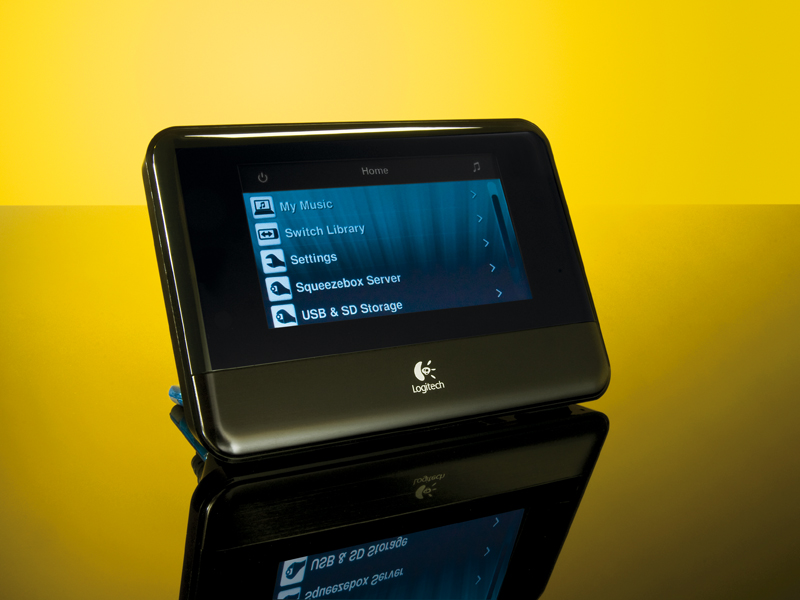TechRadar Verdict
Pros
- +
Sounds far better than anything should at this price
- +
Good build quality
- +
Easy setup
- +
Good interface and software
Cons
- -
Even briefly complaining about the Touch seems churlish
Why you can trust TechRadar
The Squeezebox Touch is nothing less than an absolute bargain. There is truly little else to say about this incredibly easy to set-up and enjoy network player.
It crams a shed-load of technology into a 150mm by 110mm enclosure, which is just 10mm deep – albeit increasing to 40mm at its base to accommodate its connection sockets.
The player delivers internet radio along with music streamed from any computer(s) on your local network. It is wireless-capable, but we used it predominantly with a CAT5E Ethernet connection to enable it to access music reliably on a computer and NAS, running the free Squeexebox Server software, which runs on Windows, Mac and Linux operating systems.
We supplied it with rips from a £370 VortexBox Appliance 1TB NAS, which conveniently comes with Squeezebox Server already installed and configured – although putting it on a Windows PC is only a five-minute job.
Fully featured
You can connect the Touch to a regular hi-fi system through a pair of RCA analogue sockets, or through a DAC using the coaxial or optical output. Equally, you can connect it straight to a set of active loudspeakers in an appropriately compact office or study system.
While inspecting the back panel you will also notice a USB port, into which you can plug a memory stick or drive containing music you would like to play. There is also an SD-slot on the side of the player, in case you wish to play music stored on an SD card.
Sign up for breaking news, reviews, opinion, top tech deals, and more.

To use either of the sources one simply selects them in the on-screen (touch-screen) display. There is also a 3.5mm headphone jack outlet for late-night listening.
We prefer using the display to control the player rather than the remote handset, but this is mainly down to personal preference and familiarity. Either way, the interface is logical and responsive.
Touching the remote control increases the size of the display font, a feature our eyes particularly appreciated on the recently reviewed and considerably more expensive Arcam Solo Neo. There is no doubt that the Touch delivers a rewarding 'user experience', one that certainly belies the budget price of the unit.
Connecting to network audio is perhaps the feature that will be most attractive to the majority of buyers, but internet radio might prove more so to those of a not especially energetic disposition. We certainly enjoyed having Radio Paradise select music for us while we sat and relaxed.
A slick package
The question of build quality does not really arise with the Touch: it is little more than a circuit board and a touch-screen, with a handful of connections pinned to the rear of the plastic case. There are no mechanical components to fail or slip out of adjustment. Everything works as it should and the whole shebang looks sleek and shiny.
Its packaging is exemplary and Logitech even thoughtfully supplies a cloth for cleaning the screen. The favourable impression created by the slick packaging is reinforced when you flick through the user manual and discover just how easy it is to get the unit connected to your network and playing.
No elevator music
It truly seems churlish to criticise the Touch overall, when one looks at what one is getting for the price: streamed audio, internet radio, alarm clock functions and all for £260 or less.
The sound is not a million miles away from that of the Slim Devices Transporter I and that was comfortably over £1,000. It will now set you back around £1,799.
Sound quality obviously varies with the source material. High-resolution FLAC files naturally sound the best. They are understandably not as detailed as they are with the high-end Linn Klimax DS or the Naim HDX, but they sound vital and alive and do not sink to background or elevator music quality as one might expect.
At the other end of the performance spectrum, decent bit-rate internet radio still sounds plausible and entertaining, even if it is not a completely audiophile experience.
The sound offers an appreciable degree of subtlety: for example, it clearly reveals deft brush work on a hi-hat by a drummer behind a female vocal. This really is not the sort of polished performance one expects from a £250 streamer. It is extraordinarily assured, enjoyable, and highly authentic in musical terms.
Dynamically, the presentation seems slightly muted, but not to the degree that any listener is moved to complain. The unit has an embedded version of the server software, so that it can replay music from a USB hard disk with no external assistance.
The software enumerates a 160GB disk very quickly and replays tracks with the same ease that it reveals when playing from the Vortexbox appliance.
A stellar performer
The Squeezebox Touch thoroughly deserves to be a phenomenal success. It is a stellar performer and can hold its own against far more expensive competition. It strikes us as being the ideal office system: it sounds good; it looks good, it is a breeze to operate and it takes up negligible desk space.
Store your music on a convenient hard disk, install Squeezebox Server, add a pair of active loudspeakers and that is it: your music is totally sorted.
Follow TechRadar Reviews on Twitter: http://twitter.com/techradarreview
